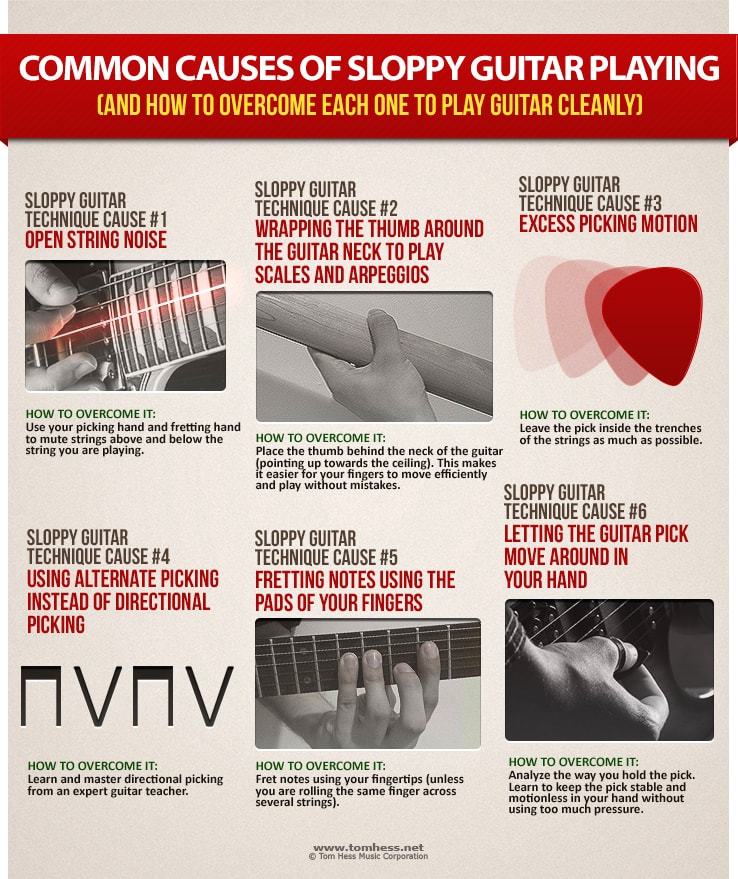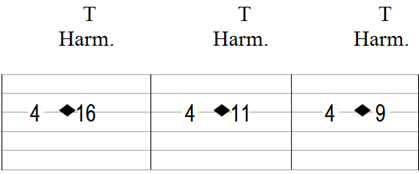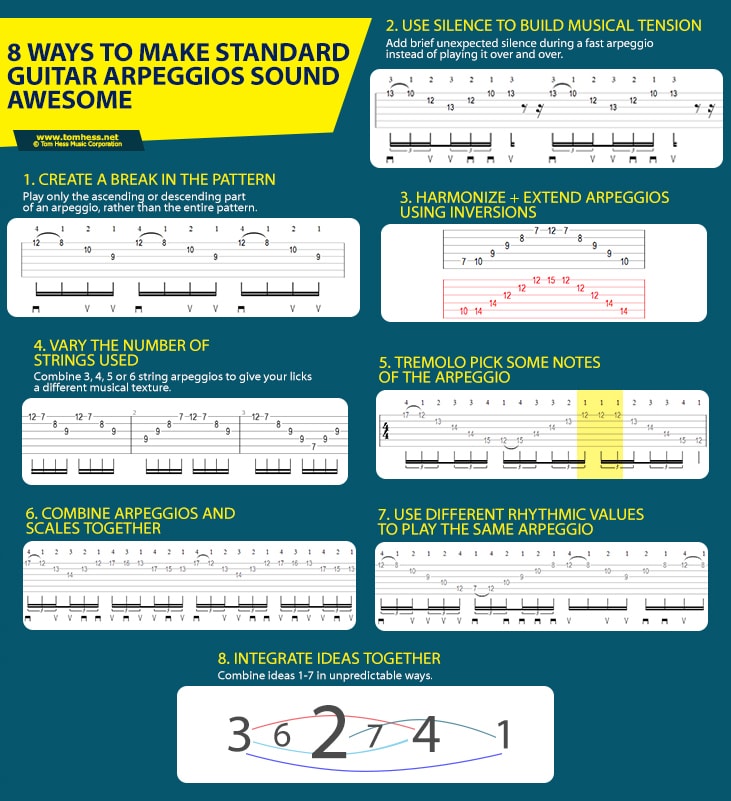How To Play Guitar Tapping Licks That Sound More Creative
Love the sound of tapping on guitar?
No doubt, guitar tapping technique is a staple for shredders and is a cool way to impress your friends with flashy licks and solos.
However:
There is much more you can do to make tapping sound amazing besides just playing blazing-fast licks.
For example, did you know that your licks can be transformed from just "pretty cool" to incredibly expressive and unique when you combine tapping with vibrato?
It's actually pretty easy to do as well!
Find out how to create awesome guitar tapping licks by combining them with vibrato by watching this video:
Click on the video to begin watching it.
The video above is just the tip of the iceberg when it comes to playing creatively on lead guitar.
Practice making your vibrato sound amazingly expressive like in the video by studying the ideas below and implementing them into your playing:
Make Sure Your Vibrato Is In Tune
How do you know if your vibrato is in tune or not?
Answer:
Your vibrato is not in tune if after the string is bent to match the targeted pitch, it is not being returned all the way back to the first pitch. This sounds really sloppy and out of control.
Make sure your vibrato stays in tune by always bending all the way up to the target and all the way down to the initial note. This can be practiced easily as an exercise by picking the target pitch and bending up to match it over and over for several minutes.
To make this practice even more effective, use a metronome and bend the note up and down to the beat.
Pay Attention To The Types Of Vibrato You Use
Did you know that there are many different types of vibrato?
That’s right!
Most guitarists rely on just one or two and use it every time they add vibrato to a note. This makes your playing become repetitive over time.
Vibrato types are based on the distance between the original note and the note being bent to, as well as the rate of speed at which it is applied.
Here are a couple of types of vibrato to try out now:
Wide and fast: This means the vibrato is a whole step or greater and moves between the target pitch and original pitch quickly. Using this style feels very intense and is great for dramatic moments during a solo (Example: Playing above a V chord before returning to the I).
Narrow and medium: This means the vibrato is less than a half step and moves between the target pitch and original pitch at a medium pace. A good way to apply this is by moving your finger side to side within the fret. It sounds great during mellow passages of a solo.
Use Vibrato To Enhance Bent Notes
Make sure not to overlook this expressive use of vibrato! This sounds very cool with the tapping approach you learned in the video as well.
While bending a string, add vibrato to the note at the apex of the bend (this is when the target note is being reached). Make sure to pay extra care to keep it in tune.
Using this together with tapping is actually easier as well.
Why?
It’s easier to bend the string when you are using both your tapping finger and your fretting finger to apply pressure. While getting started using vibrato on your bends, begin with narrow-sized vibrato until you feel comfortable staying in tune and in control.
Adding vibrato to bent notes feels amazing and makes your guitar playing scream with expressive power...
…But don’t overuse this approach.
Even something as cool as this can easily become repetitive and dull if you use it too much within a single solo or lick. At first, use it to emphasize the first or last note in a given guitar phrase.
Then slowly integrate it into your overall lead guitar playing until it feels totally natural.
Now that you are ready to play with killer vibrato, it’s time to discuss the other element in the video – guitar tapping technique.
Whether you are new to tapping or are a seasoned-veteran, there are many subtle and not subtle things to work on to develop jaw-dropping chops.
Ready to get kickass tapping skills?
Great!
Let’s begin.
Use these tips to take your lead guitar tapping to a whole new dimension:
Tip#1: Keep Your Tapping Licks Clean Using Correct Fundamentals
Tapping out patterns on guitar sounds amazing, but only when you do it cleanly.
Unfortunately, string noise quickly ruins even the coolest lick if you don't have it under control. This turns tapping licks into an exercise in frustration...
But don’t worry!
This problem of sloppy strings noises is easily solvable no matter what level you are at in your playing right now.
Here’s how to effectively eliminate string noise while tapping.
- Using your tapping/picking hand, mute any thicker strings below the one you are playing on using the area near your thumb on the inside of your palm.
- Use the side of your fretting hand index finger to mute thinner strings above the one you are playing on.
- Use any other available fingers on your picking hand to lightly sit on thinner strings above the one you are playing on.
Implement these concepts into your playing quickly by making it a priority in your guitar practice routine.
This process helps you master muting quickly so you don't have to feel the frustration that comes with sloppy notes:
Step 1: Choose any tapping lick you want to play cleanly.
Step 2: Resist the urge to play through the entire lick at once with full speed. Instead, begin by playing just the first 3 notes of the lick.
As you play them, you will focus your awareness on the exact position of both hands.
Step 3: Play the first note and check the position of your fretting hand and picking hand. Observe how clean the note is. If it is perfectly clean, move onto the next step, if it is not, reposition your hands and try again.
Step 4: Repeat step 3, except by playing the first two notes of the pattern one after the other.
Step 5: Repeat step 4, except by playing all three notes of the pattern one after the other.
Note: To make this slow, intense focus style of practice more effective, focus on each muting point individually.
For example:
Your palm on your picking/tapping hand.
The side of your index finger on your fretting hand.
The fingers you use to mute any thinner strings above the one you are playing on.
By rotating your focus from one to another, you pinpoint mistakes and clean up your playing with crazy precision.
That said, I've got even better news for you.
There are more ways to clean up your playing to make every note sound crystal-clear:
If after this process you still haven't cleaned up your playing, there is still hope.
Use the other methods shown below to clean up your guitar playing to get rid of sloppy mistakes:

Tip#2: Make Your Tapping Sound More Unique Using Rhythmic Variety
How do most guitar players use tapping technique?
Answer:
They tap notes as fast as possible while using continuous 16th notes or triplets.
This is a very interesting and flashy sound, however:
Tapping like this as your only method for using the technique is extremely limiting. Not to mention that it makes you sound just like everyone else, rather than developing your own unique style.
You want to have your own unique sound on guitar that people recognize as “you”, right?
Of course! Who doesn’t?
The way you achieve this is by using more variety in the rhythm of the notes you play while tapping.
So, how is this done?
Give this a shot:
- Choose any tapping lick or make up your own lick. Regardless of what lick you choose, make sure it is comfortable to play cleanly.
- Next, play the lick for 1 minute straight. As you do this, focus on making every repetition of the lick as different as possible using variation in the rhythm of the notes.
Additionally, use vibrato as you learned in the video or any other techniques you can think of to make the lick sound more interesting.
Not only does this help you make your guitar tapping more creative, but it enhances your overall creativity as a guitar player. This makes playing expressive lead guitar feel effortless.
Make this drill more effective by improvising with it over a backing track (with chords you make up/record or a track that works with your chosen lick).
Tip #3: Combine Tapping & Harmonics Together For A Killer Sound
Love the sound of tapping and the sound of pinch harmonics?
Well, I've got good news for you then!
It’s fairly easy to combine both techniques together to make really cool licks that sound totally killer.
First, understand this concept:
You can create harmonics on the fretboard by fretting any note, then lightly touching your finger a certain number of frets above that note. Most commonly, 12 frets higher in order to create a harmonic that is an octave above the original pitch.
After you understand this, simply do the following:
Fret any note on the fretboard.
Use your tapping finger to lightly touch around fret (the metal wiring) that is 12 frets higher than the one you chose.
For example: If you fretted the 4th fret of the G string, tap the 16th fret of the G string. Also, make sure to apply effective muting to keep the note as clean as possible.
Here are some examples:

(Harm. = Harmonic, T = Tap)
Bonus tips:
You do not have to push the string down while performing this technique. In fact, this makes it even more difficult. Use only a light touch. You’ll also see that after you play the harmonic, you are able to remove your finger from the fret entirely to let it ring.
Integrate this concept with vibrato using your fretting hand and/or tremolo bar. This sounds awesome!
Tip #4: Use Tapping To Add Fire To Your Arpeggios
Sweep picking arpeggios is easily one of the most “shred” sounds you can achieve on guitar.
Adding a tapped note to your arpeggio shapes takes your shredder status to the highest level and sounds really intense.
How do you get started with this?
Try playing a smaller, 2 or 3 note arpeggio (that you are able to play confidently) at first. This helps you focus on the tapping aspect of the lick more than sweep picking aspect.
Get creative arpeggio ideas by checking out the image below:

Next, add any note on the highest string of the highest note from the original pattern. This is the note you will tap.
Practice at a slow tempo to get down the basic movements required to combine both techniques together. This is important because most guitar players rush the tapping part and everything sounds out of rhythm and sloppy.
So, how do you sweep pick AND have the time to tap a note in such a small window?
Answer:
Have your tapping hand around the pick up area while playing. This gives you a shorter, more effective path to apply the tapped note after sweep picking.
After practicing at a slower speed, you become more familiar with the core movements needed to cleanly combine both concepts. Once this is in place, try it out at faster speeds and feel how awesome it is to play one of the coolest shredder techniques there is!
Question: “Tom Hess, I’m not really an advanced guitarist or a shredder. Is this really something I should be practicing?”
Answer: Yes, for sure! You don't need to be a super-advanced player to try this out. Regardless of your current skills or playing style, learning how to integrate these techniques together makes you a more creative guitarist.
Plus, it’s not actually that hard to do when you practice in the manner I have laid out for you. Try it out and I am confident that you will get the hang of it soon while enjoying yourself in the learning process.
Tip #5: Play Guitar Scales Without Masterful Legato Using Tapping
Playing scales fast already sounds cool enough, but using tapping together with them gives you blazing-speed and seamless legato.
This can be done in many ways, but the most straightforward way is to simply tap the final note of each string.
For example:
Try the A minor scale using 3-note-per-string scales beginning on the 12th fret of the A string.
This means you tap the following notes on the following strings if you play the entire 3 octaves:
A string: 15th fret (C)
D string: 15th fret (F)
G string: 16th fret (B)
B string: 17th fret (E)
E string: 17th fret (A)
To make these scales perfectly clean, you must keep the notes you tap from bleeding into the first note played on the next string.
This is done as follows:
After playing the tapped note, release pressure from the fret so your tapping finger is barely touching the string. This mutes the string.
Then play the next note on the next string.
By doing this, every note of the pattern sounds separately and everything sounds perfectly clean.
Nice!
Make this even easier to practice by only working on two strings at a time before you get the fundamental movements to feel smooth. Resist the urge to play through the entire pattern at once until this point.
This keeps you from becoming overwhelmed and frustrated by information overload while also helping you to stay focused on the subtle motions in each hand.
See my other guitar playing videos, available to my YouTube subscribers - follow my channel by clicking the button below:
You know how to play awesome guitar licks using tapping in a more creative manner. Now it's time to become the best lead guitar player in the room anywhere you go. Let me help you do it - get started today with interactive guitar lessons.

